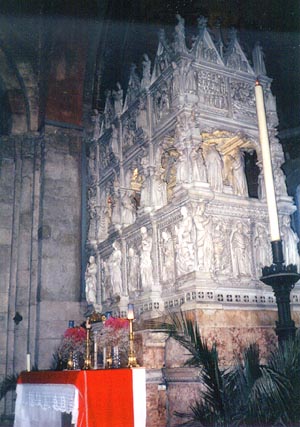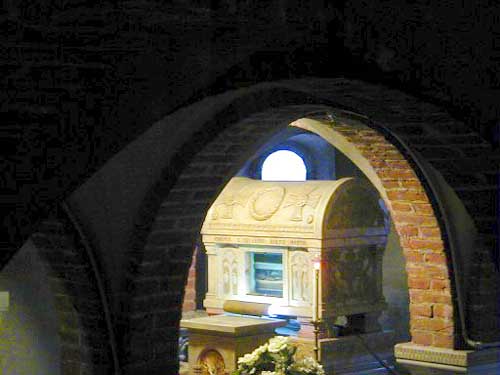Roman Catholic Saint. He is best remembered as the person who laid the foundation for the development of Western Christianity and philosophy. He was one of the four original Doctors of the Western Church and authored many books, most notably "Confessions of Saint Augustine," "City of God," and "On Christian Doctrine."
Born Aurelius Augustinus Hipponensis or Augustine of Hippo, his father was a pagan and Roman citizen who tended to be violent and loose-living, and his mother was a Christian. At age 11, he attended school at Madaurus (now M'Daourouch) and became familiar with Latin literature and pagan practices and beliefs. At age 17, he went to Carthage to continue his education.
While he had been raised a Christian, he left the Church while at Carthage and embraced the Manichaean religion. He lived a hedonistic lifestyle and had an affair with a young woman who was his concubine for over 13 years and gave birth to his son, Adeodatus.
From 373 until 374, he taught grammar at his hometown of Thagaste, and, in 375, he moved to Carthage to teach rhetoric and remained there until 383 when he moved to Rome to establish a rhetoric school there. He soon became disenchanted with Rome, and, in 384, he was introduced by friends to Symmachus, the governor of Rome, who obtained a position for him in Milan as Professor of Rhetoric for the imperial court.
While there, his mother, who had followed him to Milan, along with Bishop Ambrose of Milan, convinced him to return to Christianity. In 386 A.D., he became deeply moved by the story of Saint Anthony of the Desert and converted back to Christianity. His "Confessions" describes his account of his conversion. He was baptized by Bishop Ambrose at Milan in 387 along with his son. The following year, he completed his apology "On the Holiness of the Catholic Church" and returned with his son and mother to Thagaste. During the return trip, his mother died, and his son died not long afterward.
He then sold the property he received from his father and gave the money to the poor, retaining only the family home which he converted into a monastic foundation for himself and a group of friends. In 391, he was ordained as a priest in Hippo Regius (now Annaba) in present-day Algeria, where he became a renowned preacher. He strove to remove the Manichaean religion there and worked tirelessly to convert all to Christianity.
In 395, he was made Coadjutor Bishop of Hippo Regius and became a full Bishop thereafter, remaining in that position until his death at the age of 75. He was canonized by popular acclaim and was recognized by Pope Boniface VIII as a Doctor of the Church in 1298. His feast day is August 28, the day of his death.
Roman Catholic Saint. He is best remembered as the person who laid the foundation for the development of Western Christianity and philosophy. He was one of the four original Doctors of the Western Church and authored many books, most notably "Confessions of Saint Augustine," "City of God," and "On Christian Doctrine."
Born Aurelius Augustinus Hipponensis or Augustine of Hippo, his father was a pagan and Roman citizen who tended to be violent and loose-living, and his mother was a Christian. At age 11, he attended school at Madaurus (now M'Daourouch) and became familiar with Latin literature and pagan practices and beliefs. At age 17, he went to Carthage to continue his education.
While he had been raised a Christian, he left the Church while at Carthage and embraced the Manichaean religion. He lived a hedonistic lifestyle and had an affair with a young woman who was his concubine for over 13 years and gave birth to his son, Adeodatus.
From 373 until 374, he taught grammar at his hometown of Thagaste, and, in 375, he moved to Carthage to teach rhetoric and remained there until 383 when he moved to Rome to establish a rhetoric school there. He soon became disenchanted with Rome, and, in 384, he was introduced by friends to Symmachus, the governor of Rome, who obtained a position for him in Milan as Professor of Rhetoric for the imperial court.
While there, his mother, who had followed him to Milan, along with Bishop Ambrose of Milan, convinced him to return to Christianity. In 386 A.D., he became deeply moved by the story of Saint Anthony of the Desert and converted back to Christianity. His "Confessions" describes his account of his conversion. He was baptized by Bishop Ambrose at Milan in 387 along with his son. The following year, he completed his apology "On the Holiness of the Catholic Church" and returned with his son and mother to Thagaste. During the return trip, his mother died, and his son died not long afterward.
He then sold the property he received from his father and gave the money to the poor, retaining only the family home which he converted into a monastic foundation for himself and a group of friends. In 391, he was ordained as a priest in Hippo Regius (now Annaba) in present-day Algeria, where he became a renowned preacher. He strove to remove the Manichaean religion there and worked tirelessly to convert all to Christianity.
In 395, he was made Coadjutor Bishop of Hippo Regius and became a full Bishop thereafter, remaining in that position until his death at the age of 75. He was canonized by popular acclaim and was recognized by Pope Boniface VIII as a Doctor of the Church in 1298. His feast day is August 28, the day of his death.
Bio by: William Bjornstad
Family Members
Advertisement
See more Augustine memorials in:
Explore more
Sponsored by Ancestry
Advertisement






